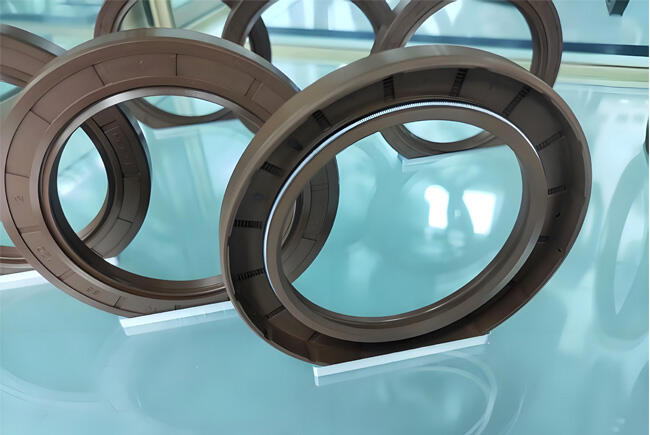In industrial machinery, oil seals are often the unsung heroes. They prevent lubricant leakage, block contaminants, and protect rotating shafts — all while operating under pressure, heat, and friction. Yet, despite their critical role, oil seals are frequently blamed when systems fail. The truth is, most seal failures are not due to poor quality, but rather to mismatched materials, improper installation, or overlooked maintenance.
For distributors and wholesalers, understanding what truly affects oil seal lifespan is more than technical knowledge — it’s a way to reduce returns, build trust, and offer real value to customers.
Material Selection: The First Line of Defense
The choice of material directly determines how well a seal performs under specific conditions.
Nitrile rubber (NBR) is suitable for general-purpose lubrication but degrades quickly in high temperatures or aggressive chemicals.
Fluoroelastomer (FKM) offers excellent resistance to heat and chemicals, making it ideal for automotive and chemical processing.
Polyurethane (PU) provides high wear resistance, often used in hydraulic systems.
Distributors should always ask about the operating medium, temperature range, and pressure before recommending a seal. NQKSF is custom service team often starts with a material audit, ensuring the compound matches the real-world conditions — not just the spec sheet.

Operating Conditions: Heat, Pressure, and Speed
Oil seals are sensitive to their environment.
Excessive heat accelerates rubber aging, leading to hardening and cracking.
High pressure can deform the sealing lip or push the seal out of its housing.
High-speed rotation increases friction, which can cause thermal buildup and wear.
In such cases, standard seals may not suffice. NQKSF’s engineering team often recommends reinforced designs — such as metal-cased seals or dual-lip configurations — tailored to the customer’s equipment.
Shaft Surface and Alignment
Even the best seal will fail if the shaft it rides on is flawed.
Surface roughness should be within recommended limits to avoid premature wear.
Shaft misalignment causes uneven contact, leading to leakage and lip damage.
Before installation, technicians should inspect the shaft for burrs, scoring, or eccentricity. NQKSF’s technical support often provides on-site guidance, helping clients avoid these common pitfalls.
Installation Practices
Improper installation is one of the leading causes of early seal failure.
Using sharp tools can nick the sealing lip.
Overstretching the seal during placement can cause permanent deformation.
Failing to lubricate the lip before startup increases friction and wear.
NQKSF recommends using dedicated installation tools and compatible lubricants. Their “technical empowerment” program includes training modules for maintenance teams — a service that many distributors now offer as part of their value-added package.
Contaminants and Fluid Compatibility
Seals are exposed to more than just oil.
Dust, metal particles, and water can enter the system and erode the seal.
Additives in lubricants may react with the rubber compound, causing swelling or degradation.
This is why NQKSF is custom seal service includes fluid compatibility testing. For critical applications, they even offer multi-material sealing systems to handle complex media.
Maintenance and Replacement Cycles
Even a perfectly installed seal has a finite lifespan.
Regular inspection can catch early signs of wear.
Scheduled replacement prevents catastrophic failure.
Distributors can help customers set realistic maintenance intervals based on usage patterns. NQKSF’s inventory system supports rapid dispatch of standard seals — with over 10,000 specifications in stock — ensuring minimal downtime during planned maintenance.
FAQ
Q: Why do some seals fail within months while others last years? A: It’s rarely about the seal itself. Material mismatch, poor installation, or harsh operating conditions are usually to blame. A proper needs assessment is key.
Q: Can you deliver seals quickly for urgent repairs? A: NQKSF offers fast dispatch of standard parts, including O-rings and oil seals. Their warehouse system is optimized for emergency response.
Q: What if my customer’s equipment needs a non-standard seal? A: NQKSF provides full customization — from design to testing — ensuring the seal fits both the geometry and the operating conditions.
Oil seal lifespan is not determined by a single factor. It’s the result of correct material selection, precise installation, and proactive maintenance. For distributors and wholesalers, offering technical insight and responsive service is no longer optional — it’s what separates a vendor from a partner.
NQKSF, as a high-tech enterprise and industry leader, combines a smart manufacturing base with global reach — supplying to over 80 countries and recognized as a provincial innovation center and specialized enterprise. Their commitment to technical empowerment, custom solutions, and fast logistics makes them a trusted ally for distributors seeking long-term growth.
In sealing systems, reliability isn’t just built — it’s supported, optimized, and delivered.
 Hot News
Hot News